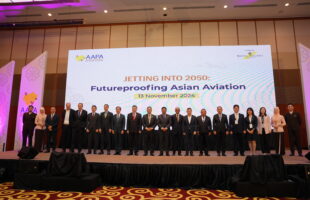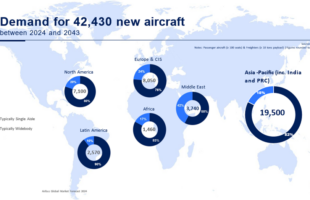Over 24 million jobs and US$470 billion in GDP in the Asia-Pacific region are supported by aviation, according to a new report released today at the Aviation and Environment Summit in Geneva. The report, ‘Aviation: benefits beyond borders,’ was produced by the Air Transport Action Group (ATAG) and Oxford Economics. It outlines an industry that plays a larger role in both the Asia-Pacific and global economy than many would expect.
“In the Asia-Pacific region alone aviation directly employs over two
million people,” says Paul Steele, executive director of ATAG, the global air transport association. “If we include indirect employment at suppliers to the industry, induced employment from spending by
aviation industry employees and the jobs in tourism that air transport makes possible, this increases the regional figure to 24.1 million jobs. In addition, Asia Pacific economies derive substantial
benefits from the spending of tourists travelling by air.
“Of course, aviation’s economic benefits spread far beyond the monetary aspects outlined here. When you take into account the further benefits gained through the speed and reliability of air travel, the businesses that exist because air freight makes them possible and the intrinsic value to the economy of improved connectivity, the economic impact would be several times larger,” adds Steele.
For Asia-Pacific forecasts indicate that cargo volumes are projected to rise at a rate of 6.3 per cent per annum while passenger numbers are expected to almost triple from 779.6 million in 2010 to over 2.2 billion in 2030. The report also outlined the role aviation plays at a global level, supporting 56.6 million jobs worldwide and $2.2 trillion of the world’s GDP. There are some 1,500 commercial airlines using nearly 24,000 aircraft to serve 3,800 airports around the globe.
Commenting on the findings, Andrew Herdman, director general of
the Association of Asia Pacific Airlines (AAPA) added: “Aviation plays a critically important role in fostering successful economic and social development, particularly here in Asia. This report highlights the fact that the Asia-Pacific region already accounts for 34 per cent of passenger traffic worldwide, ahead of both Europe and North America (27 per cent each), led by dynamic growth in
the major emerging economies. Looking ahead, the Oxford Economics analysis suggests further growth can provide an
additional 1.4 million jobs in aviation across the region by 2030 – and if you include the tourism benefits, up to 4.6 million jobs.”
“While we are now the largest region in the world for passengers, the existing and projected growth in demand for air transport services will require a renewed focus on infrastructure development,” says Patti Chau, regional director of Airports Council International Asia- Pacific. “Any development needs to
happen in a strategic and sustainable way that benefits the communities we serve, the economy and also ensures limited
impact on our precious environment.”






